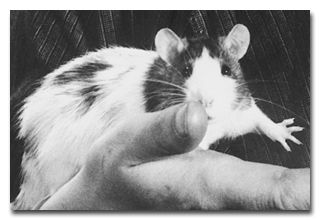|
My
1983 “Lilac” Rats
|
|
|
In 1982 I was given a rat of an unusual colour, and began a breeding programme to discover more about the new shade. Some years later in 1987, two years after I stopped breeding rats the first time round, I wrote this article about them which I unearthed during a house move last year. |
|
| In
1982 I organised a show for the NFRS to be held in Street, Somerset;
the first of the Wessex area shows. All that is past history now—
the show attracted a large entry and was a great success, being
held in conjunction with a small-pets show and attracting much media
attention in the area. But for me it was also the beginning of one of my most exciting periods of small animal breeding - I found a new colour of rat. |
|
| One of the exhibitors at the show who had travelled from Dorset to attend, mentioned that he had bought a weird-coloured rat at a pet shop in Wimborne, Dorset, and when I expressed an interest he agreed to bring the rat along for me to see. And I saw what I immediately suspected to be some kind of a dilute agouti. Blue Vinney - named after the rare Dorset blue cheese - was a variegated-berkshire of an unusual bluish, misty-looking agouti colour. | |
| Vinney
had recently had a litter, and I was given her, plus three of her
babies sired by a Cinnamon buck. Vinney went to live with Ann Storey,
and I began breeding with the trio of babies to produce more rats
of this unusual colouring, dubbed Pastel. MARIE was an Agouti Berkshire doe; HEATHCLIFF a Cinnamon hooded/capped buck; and the third, MUESLI, a similar Cinnamon hooded/capped doe. |
|
|
I had
several litters from the two girls Muesli and Marie, put to Heathcliff
of course, and from the litters emerged more unusually coloured
rats— notably, HELVA, a pastel doe (capped) and DAPPER,
a capped pastel buck. Some also had blazes on the head and face— MALLEN was an agouti variegated doe from this line who had an unusual Dutch-rabbit blaze. |
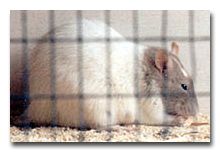 Helva |
|
And
soon after, LIO was bred— the first rat of the colour
I termed “lilac”. He was a capped with too much colour,
but that colour which started out looking rather like Mink, turned
into a lighter bluer shade. His children, when bred back to a
Pastel doe, were also self (non-agouti) rather than agouti, and
some were even more lilac-y, developing a lovely pink tinge when
adult. Critiques from the shows were directed at the minkish colour they appeared to be— they got short shrift as poor minks but I remained unconvinced; if the appearance was deceptive, I knew that genetically they were not mink and not cinnamon, they were something different. I kept Blue Vinney firmly in mind. If the “lilacs” looked Mink, the “lilac” pastel agoutis were definitely more of a difference from Cinnamon. |
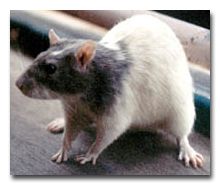 Lio |
| Rats being rats, the next stage was something of a slight accident. I now had several Pastels and one “Lilac”, all capped or variegated and I now needed to try and get them with more colour on the body, if only to prove a point. When a rat has colour only on the head, anyone could be forgiven for saying the colour couldn’t be properly seen. Nezumi provided the answer. She was a large and typy Siamese doe from Geof Izzard’s breeding, and she eloped with Lio one night! I kept one of the kittens, a beautiful big black Berkshire doe named Firân. Her markings weren’t bad for a Berkshire and she won a large Berkshire kitten class at the London Championship show that year. When bred back into the Pastel line I at last had rats of this colour with Berkshire markings rather than capped. But they still got the same old comment at shows: “poor mink.” | 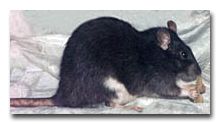 Firân |
| About this time my Variegated rats were coming on well and I was invited to send a pair over to the USA when the NFRS was contacted for export to the American rat fancy. pedigrees were requested and I added a rider to the effect that my rats - the Variegated - had come from an experimental line and could therefore be carrying unusual genes. As by now I had established to my own satifaction that the Pastel and “lilac” was recessive, there was a high likelihood that they did. | 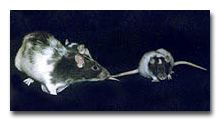 |
|
Other
people had some of my Variegated and Pastel rats from me, and
a few years later both Rosemary Quaid and Diane Wildman produced
Black-eyed Whites by selectively breeding out the colour on lightly
marked Capped and Variegated. Rats from my Pastels were included
in their development. |
 |
|
|
|
|
NOTES: 2002 Several
years after I gave up rats, the geneticist Roy Robinson
investigated the genetic make-up of Black-eyed Whites. He discovered
a gene which he called h(e) = extreme hooded. Both Ann
Storey and myself agree this gene is probably what my Pastels
were, since the Black-eyed Whites he conducted his experimental
breeding with were obtained from Rosemary Quaid, who had used
a number of my Pastels in the origination of her Black-eyed White
lines. I'd like to point out that the "Lilacs" mentioned in this article are not genetically related to the variety known as Lilac in the USA - which is a form of lightened Mink but not linked to any white spotting pattern - or the variety standardised as Lilac in the UK, which is a combination of standard Blue, Chocolate and possibly also one gene for Red eye dilution.
|
|
